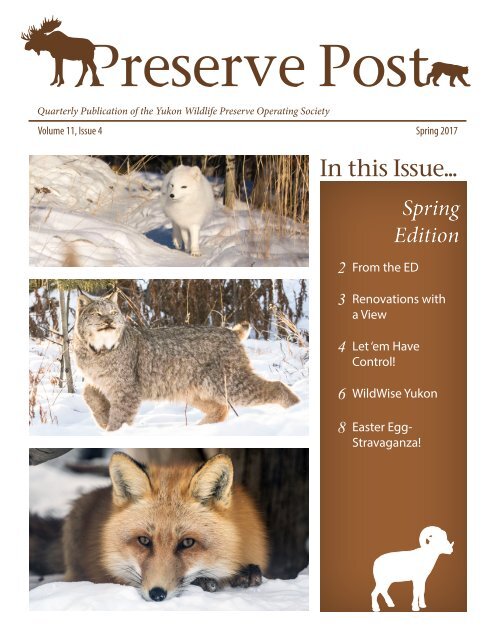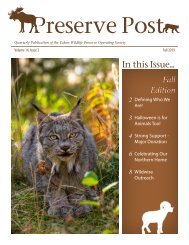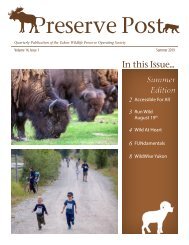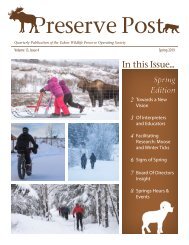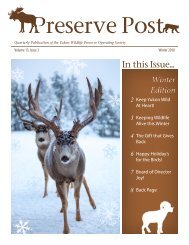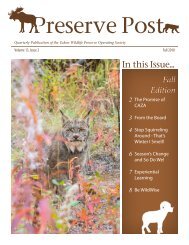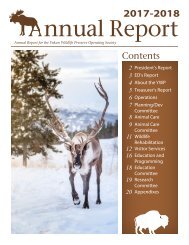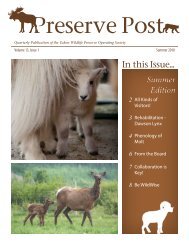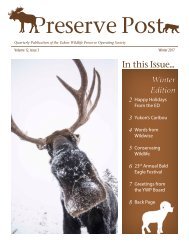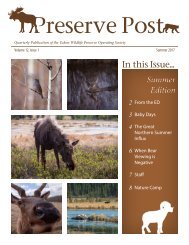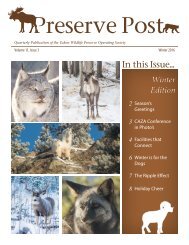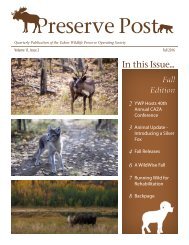Preserve Post 2017 Spring Newsletter
Enjoy all that Spring offers; projects, events and some words from our partners at WildWise Yukon and American Bald Eagle Foundation.
Enjoy all that Spring offers; projects, events and some words from our partners at WildWise Yukon and American Bald Eagle Foundation.
You also want an ePaper? Increase the reach of your titles
YUMPU automatically turns print PDFs into web optimized ePapers that Google loves.
Quarterly Publication of the Yukon Wildlife <strong>Preserve</strong> Operating Society<br />
Volume 11, Issue 4<br />
<strong>Spring</strong> <strong>2017</strong><br />
In this Issue...<br />
2 From the ED<br />
3 Renovations with<br />
a View<br />
4 Let ‘em Have<br />
Control!<br />
6 WildWise Yukon<br />
8 Easter Egg-<br />
Stravaganza!<br />
<strong>Spring</strong><br />
Edition
<strong>Spring</strong> Greetings from the<br />
Wildlife <strong>Preserve</strong><br />
We have been having a wonderful winter at the<br />
<strong>Preserve</strong> with strong visitation numbers from both<br />
our valued resident market and our visitor market.<br />
The inbound Travel Trade appears to have been having<br />
a very strong season to-date. Our pilot March Break<br />
Nature Camp is sold out and teachers are signing up<br />
their classes for our upcoming School Program. It is<br />
looking like we will all be busy beavers this spring and<br />
summer – just the way we like it!<br />
As is our nature, we have a number of exciting new<br />
projects and initiatives on the go. These include:<br />
• We have been hired by the Department of<br />
Environment (Wildlife Viewing) to deliver the<br />
Swan Haven Interpretive School Program. This is<br />
a pilot and if all goes well, we may be looking at a<br />
longer-term arrangement;<br />
• We have successfully accessed substantial funding<br />
from CanNor through the Canada 150 Community<br />
Infrastructure Program (CIP) which will allow<br />
us to completely update all of our mountain goat<br />
fencing – including a number of new holding<br />
areas and the re-opening of a lovely, flat walking/<br />
skiing/biking route running from behind the red<br />
fox habitat down the valley bottom to the moose<br />
pasture – you will be able to avoid our two steep<br />
hills; and<br />
• We have successfully accessed funding through<br />
Yukon Government’s Community Development<br />
Fund (CDF) to undertake some landscaping<br />
and other improvements around our reception<br />
cabin in an effort to provide the <strong>Preserve</strong> better<br />
representative “curb appeal”.<br />
On top of all this, in early August we will be<br />
welcoming the CAZA Accreditation Inspection Team<br />
to re-evaluate the <strong>Preserve</strong> for continued accreditation.<br />
It is hard to believe that it has been five years since we<br />
first received accreditation! Every five years we have<br />
to start from scratch and re-do the full accreditation<br />
process. We are confident that we will once again,<br />
achieve unconditional accreditation status.<br />
Finally, thank you to everyone local or distant, for your<br />
continued support!<br />
Bring on summer!<br />
Photos: Bull moose in snow just a week before he shed his<br />
antlers. Cover photos, from top to bottom: It’s only at about -45<br />
degrees Celsius and colder does an arctic fox need to increase its<br />
metabolism to stay warm; Lynx use their ear tuffs to hear better;<br />
red foxes are incredibly cunning and intelligent, distributed<br />
across the entire Northern Hemisphere!<br />
2<br />
Volume 11, Issue 4
Renovations<br />
With a View<br />
Kilometres of new fence, hundreds<br />
of new fence posts, steep and rugged<br />
cliffs... sound like fun?<br />
Over the coming weeks and months<br />
<strong>Preserve</strong> staff will undertake a huge<br />
fencing upgrade along the back<br />
cliff where the mountain goats live.<br />
The fence is starting to show its age<br />
and part of the back cliff sits empty<br />
for this reason. It will also simplify<br />
seasonal animal movements required<br />
to manage our amazing mountain<br />
goat herd. Finally, it will open up a<br />
new walking trail for visitors to the<br />
<strong>Preserve</strong> - enabling stunning, close<br />
views of the mountain goat cliff that<br />
most have never experienced!<br />
The hard work has already begun.<br />
Operations staff are busy currting 30’<br />
steel posts into 10’ fence post lengths.<br />
Soon they’ll start laying them out<br />
along the new fence line. This is where<br />
it gets tricky though. Putting fence<br />
posts into a rocky, cliff environment<br />
is no easy feat. It will take a rock drill<br />
to sink most of the posts. On softer<br />
ground its easier to dig the holes, but<br />
they also collapse faster - so while it<br />
might seem<br />
odd to be<br />
working away<br />
in the cold,<br />
the frozen<br />
ground will<br />
actually help<br />
keep the<br />
holes open!<br />
Above: posts and fencing stand ready. The repairs and renovations will open up<br />
a path along the bottom of the back cliff giving visitors new areas to explore and<br />
enjoy!<br />
<strong>Spring</strong> <strong>2017</strong><br />
3
Let ‘em Have Control!<br />
This past February I had the opportunity to speak at<br />
the International Association of Avian Trainers and<br />
Educators’ conference about how important choices<br />
are to the animals (and humans) we share our lives<br />
with. While my topic focused on the importance of<br />
choices to the American Bald Eagle Foundation’s 12<br />
avian ambassadors, in reality this concept should be<br />
broadened to all of our relationships human, and<br />
animal.<br />
In animal training we talk a lot about reinforcers.<br />
Some reinforcers are things that animals work toward<br />
earning to ensure individual and species survival.<br />
They can include things like food, water, sleep and<br />
reproduction.<br />
A reinforcing event is anything that occurs that will<br />
strengthen an animal’s (don’t forget humans are<br />
animals) future behavior. This means that if an animal<br />
is successful at obtaining a reinforcer (such as food)<br />
then it will repeat the same behavior it performed in<br />
order to obtain the reinforcer in the future. Trainers<br />
often use reinforcers to encourage animals to<br />
participate in training, husbandry and outreach events.<br />
For example, when we ask bird to step up on the glove,<br />
and it chooses to do so, the bird gets reinforced with a<br />
tid-bit of quail.<br />
This information may be a bit difficult to digest, so to<br />
put it more simply; we can ask<br />
for, and strengthen behaviors by<br />
reinforcing with something that<br />
the animal would work to earn<br />
on its own.<br />
control.<br />
One reinforcer I frequently<br />
see overlooked is control. It’s<br />
easy to overlook control as a<br />
reinforcer because it’s not a<br />
reinforcer we think of working<br />
toward earning. However<br />
when we begin to think about<br />
being forced around and<br />
pushed into every action we<br />
make, we begin to feel a loss<br />
of choice in our lives and we<br />
start to feel helpless. It’s vital<br />
to the health and welfare of our<br />
relationships with humans, and<br />
animals that we begin to utilize<br />
the reinforcing properties of<br />
Think about it this way: would you rather be physically<br />
forced to do dishes, take out the garbage, shovel snow;<br />
or asked to do these chores and then be rewarded<br />
with your favorite snack or praise from a loved one<br />
afterward? In the latter circumstance, not only are<br />
you choosing to perform this event, but you know<br />
that there is a reward for you in participating in these<br />
chores.<br />
4<br />
Above: Eurasian eagle owl Hans is asked to step-up to come out of his aviary.<br />
The owl has a choice. If he chooses to step-up he gets reinforced with food. If he<br />
chooses not to, the trainer respects the decision and leaves.<br />
Volume 11, Issue 4
When we give those in our lives<br />
choices and control over their<br />
lives, we open up the door to<br />
more positive and rewarding<br />
relationships. Further, we can<br />
reinforce behaviors we like. For<br />
example, when your dog lays<br />
down in the living room instead<br />
of begging at the table she receives<br />
a “good girl” and a scratch on the<br />
head (the reinforcing praise and<br />
scratch on the head makes the<br />
laying down in the living room<br />
behavior more likely to occur in the<br />
future).<br />
In order for us to improve the<br />
lives of animals we share our lives<br />
with, and to improve the quality<br />
of our human relationships, we<br />
must recognize the reinforcing<br />
(remember reinforcement makes the behavior more likely to occur) value of control. Only then can we begin to<br />
build positive relationships based on rewarding histories.<br />
Leia Minch is the Raptor Curator for<br />
the American Bald Eagle Foundation in<br />
Haines, Alaska. She manages the health<br />
and welfare of the 12 avian ambassadors<br />
that live and work at the facility. She feels<br />
one of the most important aspects of her<br />
job is connecting humans to the natural<br />
environments that we live and thrive from.<br />
Visit the American Bald Eagle Foundation<br />
in Haines, Alaska. The facility is currently<br />
open Monday to Friday’s 9am - 3pm .<br />
* Chance, Paul. “Operant Applications and Interpretations.”<br />
Learning and Behavior. 6th ed. Belmont,<br />
CA: Wadsworth Pub., 1988. 250-51. Print. Ser. 2008.<br />
<strong>Spring</strong> <strong>2017</strong><br />
Top: A group winter walking the trails tucked in behind the Learning Centre at<br />
the Yukon Wildlife <strong>Preserve</strong> - next time you visit check them out! Left: Resident<br />
bald eagle is asked to step-up onto the scale for a regular weight check. Re-inforcement<br />
with food is provided is the bird obliges.<br />
5
The Physiological Wonders of<br />
a Deep Winter Slumberer<br />
Bears in Yukon Territory<br />
traditionally hibernate until around<br />
the end of April. i Most of us know<br />
that bears spend the summer and<br />
fall months bulking up for a long<br />
winter of sleeping and fasting,<br />
but one may not know that many<br />
bears’ winter sleeping habits are<br />
evolutionarily fascinating.<br />
Firstly, bears actually do not<br />
hibernate. During the cold,<br />
food-scarce months, bears enter<br />
a state of torpor. Animals in<br />
torpor only decrease their body<br />
temperature a few degrees, and<br />
reduce their breathing and heart<br />
rates minimally. With hibernation,<br />
animals reduce their metabolic<br />
rates substantially. Torpor can<br />
be considered a ‘deep sleep’, but<br />
animals can become awakened if<br />
needed. ii<br />
During torpor, bears do not<br />
eliminate wastes such as urea and<br />
nitrogen. High levels of these<br />
compounds in the blood are usually<br />
fatal, but bears have evolved unique<br />
strategies to solve this problem.<br />
Bears recycle<br />
these waste<br />
products by<br />
converting<br />
them into lean<br />
muscle mass<br />
while sleeping.<br />
iii<br />
Additionally,<br />
immobility<br />
in an animal<br />
usually leads<br />
to both muscle<br />
and bone<br />
density losses.<br />
Although bears<br />
are highly<br />
sedentary<br />
throughout the<br />
winter months,<br />
they are able to somewhat maintain<br />
these facets of their body condition<br />
through a variety of unique<br />
physiological changes. iv,v<br />
With spring around the corner<br />
WildWise Yukon would like to<br />
take an opportunity to ask if you<br />
are prepared for emerging bears?<br />
Use the<br />
Backyard<br />
Checklist:<br />
https://goo.gl/<br />
DVRdbG<br />
A few ways to<br />
be WildWise<br />
this spring!<br />
• Garbage<br />
- secured with certified bearproof<br />
containers or indoors;<br />
• Domestic farm animals<br />
protected with electric fencing;<br />
• Compost - turned regularly, add<br />
odor dampers, electric fence<br />
protected;<br />
• Bird feeders - put them away<br />
for the spring/summer;<br />
• Pet food - secured inside;<br />
• BBQ’s/freezers/smokers cleaned<br />
and concealed inside.<br />
The Yukon Wildlife <strong>Preserve</strong> and<br />
WildWise Yukon are building on<br />
their partnership in many ways<br />
including a project focused on<br />
creating a Bear Learning Module<br />
to be implemented in curriculum<br />
across Yukon Territory. The<br />
curriculum will include various<br />
6<br />
Top: a bear necessity slumber - bear.org; A bear tests this bear-proof garbage<br />
system (Haul All Equipment Services). Facing page: the large ears of the aptly<br />
named mule deer move independently allowing them to hear even better!<br />
Volume 11, Issue 4
stakeholders including First Nation<br />
Tradition Knowledge. WildWise<br />
Yukon and Yukon Wildlife <strong>Preserve</strong><br />
partner through advocacy for<br />
education and conservation. For<br />
more about WildWise Yukon visit<br />
www.wildwise.ca or give us a call<br />
335-5212. We would be happy to<br />
hear from you!<br />
Cassandra Andrew is a volunteer<br />
board member for WildWise Yukon,<br />
and is currently enrolled at Western<br />
College of Veterinary Medicine -<br />
Doctor of Veterinary Medicine 2019.<br />
Candidate.<br />
i<br />
Environment Yukon. 2016. American Black Bear. Accessed online from: http://www.env.gov.yk.ca/<br />
animals-habitat/mammals/blackbear.php.<br />
ii<br />
Telus Science World. 2016. Do Bears Actually Hibernate? Accessed online from: https://www.<br />
scienceworld.ca/blog/do-bears-actually-hibernate.<br />
iii<br />
National Park Service. 2016. Denning and Hibernation Behaviour. Accessed online from: https://<br />
www.nps.gov/yell/learn/nature/denning.htm.<br />
iv<br />
Chow BA, Donahue SW, Vaughan MR, McConkey B, Vijayan MM. 2013. Serum Immune-Related<br />
Proteins are Differentially Expressed during Hibernation in the American Black Bear. PLoS ONE<br />
8(6):e66119. doi:10.1371/journal.pone.0066119.<br />
v<br />
McGee-Lawrence ME, Carey HV, Donahue SW. 2008. Mammalian hibernation as a model of<br />
disuse osteoporosis: the effects of physical inactivity on bone metabolism, structure, and strength.<br />
American Journal of Physiology: Regulatory, Integrative, and Comparative Physiology 295: R1999–<br />
R2014.<br />
Full-time Staff<br />
Yukon<br />
Wildlife<br />
<strong>Preserve</strong><br />
Greg Meredith, Executive Director<br />
Sheila Downey, Executive Assistant<br />
Randy Hallock, Operations Director<br />
Dr. Maria Hallock, Wildlife Curator<br />
Jake Paleczny, Director of<br />
Programming & Education<br />
Lindsay Caskenette, Manager of<br />
Visitor Services<br />
Daniel Jolkowski, Animal Care &<br />
Operations Assistant<br />
Beth Paul, Senior Education<br />
Programmer<br />
Board of Directors<br />
Alexandra Tait President<br />
Lacia Kinnear, 1 st Vice-President<br />
Michael Kokiw, 2 nd Vice-President,<br />
Kristine Hildebrand, Treasurer<br />
Jessie Dawson<br />
Chris Evans<br />
Katelyn Friendship<br />
Kirk Cameron<br />
Brooke Rudolph<br />
Shirley Adamson<br />
Shawna Warshawski<br />
Ed van Randen Non-voting Member<br />
- Environment Yukon<br />
Darrell March, Non-voting Member -<br />
Environment Yukon<br />
<strong>Spring</strong> <strong>2017</strong><br />
7
Above: Scarface and a juvenile male mountain goat claim the highest land as the sun sets in their temporary habitat.<br />
EGG-stravaganza!<br />
Scavenger Hunt<br />
The Wild Easter fun returns<br />
Monday April 17 th . Take part<br />
anytime between 10:30am-5:00pm.<br />
What is the Easter Hare up to<br />
this year?!<br />
Follow the clues, you will need<br />
to be wise as they will lead you to<br />
a chocolatey prize! Bring your<br />
family and friends, little by little<br />
help one another piece together<br />
the riddle.<br />
Regular rates apply. Members get<br />
in free! A great opportunity to re-new or<br />
purchase your membership<br />
for access to this eggcellent<br />
event and others<br />
throughout the year!<br />
When to Visit<br />
Winter Hours<br />
10:30am to 5:00pm: Friday - Sunday<br />
Guided Bus Tours at 12pm, 2pm.<br />
Extended March Break Hours<br />
Open Daily March 17 th to April 2 nd .<br />
Walk, run, fat-bike anytime while open. We also<br />
highly encourage skipping! Enjoy the multi-use<br />
winter trails for skiing.<br />
Curious about the latest news? Visit<br />
facebook.com/yukonwildlife or call 456-7300.<br />
We’re on Instagram now!<br />
Share your adventures with us through Social Media<br />
and we`ll re-share our favs! Tag us #YukonWildlife<br />
Writing: Lindsay Caskenette, Greg Meredith,<br />
8<br />
Leia Minch, Jake Paleczny, Cassandra Andrew<br />
Photos and illustrations: Lindsay Caskenette, Jake Paleczny,<br />
Printed on 100% Recycled Volume Paper 11, Issue 4


